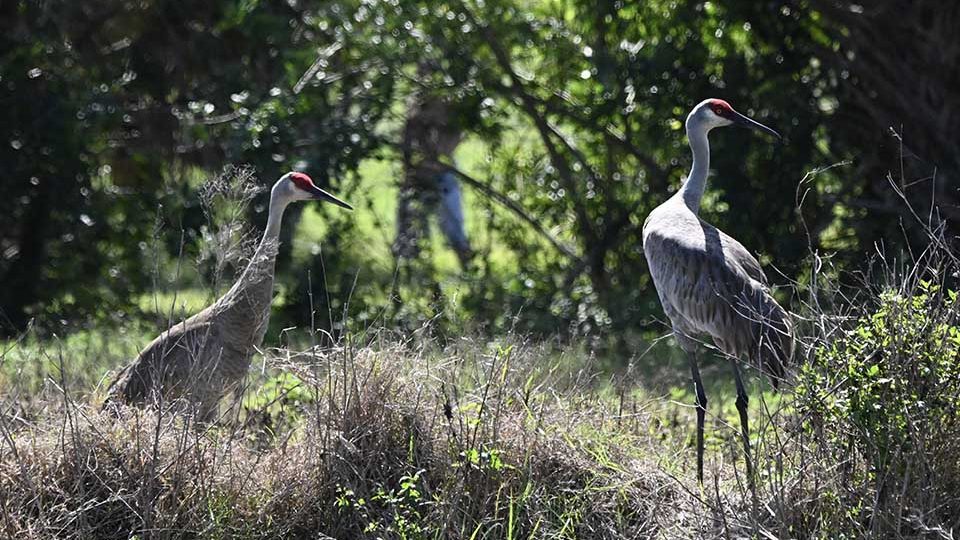Crane or Heron?
...that is the question for our columnist on a trip to Ireland, where she puts her bird identification skills to good use.


As I write this column, my husband and I are visiting Carlingford, Ireland, a medieval town along the east coast near the border of Northern Ireland. It is on the Carlingford Lough (fiord); the southern side is Ireland and the northern shore is Northern Ireland. The area is best known for its oyster farms, medieval buildings, and outdoor activities. The stony mudflats have numerous shorebirds, many species of which are the same as in southern New Jersey, while others are not. On the shrubby marsh borders we are treated to the popping up and down of stonechats, a new bird for me.
At breakfast I inquire of our B&B innkeeper Wendy, “What are the favorite spots for local birding?” She immediately tells us that she has a crane that visits her yard, primarily in the early evening.
“A crane? Really, what kind?” I ask, trying to hide my skepticism.
“Well, I don’t know; you’ll have to tell me,” Wendy replies with a hint of brogue.
After discussing her suggestion of a resident crane, I decide she likely doesn’t know a duck from a hummingbird. But I don’t hold this against her, especially since she has proven to be extremely knowledgeable about the region on a vast number of topics. She is especially up on President Biden’s April 2023 visit to Carlingford and encourages us to follow his itinerary as it applies to the Cooley Peninsula. And we do.
Meanwhile my husband confides that he saw what he thought to be a great blue heron in the yard.
I do a bit of digging and find out that Ireland’s common cranes became extinct sometime between 1600 and 1700, pressured by foxes, hunting, and habitat destruction. So it’s not looking any better for Wendy’s birding identification skills. She had best stick to medieval structures and Presidential graveside visits.
But wait, it turns out that for the past two years, a pair of common cranes have nested in Bord na Móna, the 20,000-acre midlands region in which peat is harvested. However I can assure you that it is unlikely these have made the trip to Wendy’s yard.
The extraction of turf remains controversial in Ireland and is considered possibly the most unfriendly form of fuel, yet it is still subsidized by the government. The Bord na Móna bog fields are undergoing a restoration effort, and the portion that is returning to nature is where the cranes are nesting. I’ll give a shameless plug to one of my former stories on sphagnum moss, in which I discussed peat and the preservation of bodies, with the teaser that you can find all prior stories on the CU Maurice River website (cumauriceriver.org) under education: “The Great Outdoors.”
To be honest, most people don’t know the difference between herons and cranes. In southern New Jersey you won’t need this skill often, but to the delight of local birders in Salem and Cumberland counties we do get a few resident sandhill cranes. Every few years an escapee exotic crane, or a very wayward whooping crane, may also be spotted—while extremely unusual, never say never.
First of all cranes are members of the Gruidae family and only two species are in North America—the sandhill and whooping crane. Herons, on the other hand, belong to the Ardeidae family of which there are essentially six species—the great blue, the green, the little blue, the tricolored, and the black-crowned and yellow-crowned herons.
This excludes the exotic western-reef heron and vagrants from Central America. I’ve never heard of a vagrant heron from Central America making it into the wilds of New Jersey, but then I’d never heard of a caracara (falcon) being in our area until there was one.
The great blue does have a white and intermediate phase that’s confined to Florida and sometimes confused with great egrets, the same species but a topic for another time. Thus, the only heron that could be mistaken for a great blue heron, in our region, is the sandhill crane. Let’s talk about their distinctions as well as the general differences between the Gruidae and Ardeidae families.

Flight characteristics are rather easy to call out. Cranes and herons both fly with outstretched legs, but herons’ necks make an S in order to rest their heavy head upon their shoulders, while cranes fly with the neck outstretched. Herons have a deep, slow, curved wingbeat that does not result in the wings extending above the body while cranes have a straight wingbeat that is more rapid and extends the wings high above the body.
If you happen to hear one call, which they often do when taking off or flushing, herons emit a distinctive croak. Sandhill cranes, on the other hand, rattle (sometimes described as a bugle), and a pair can sound like a loon on steroids.
Herons can perch and nest in trees, but cranes nest on the ground and in fact are unable to perch. Herons nest in colonies but are rather solitary when the season for raising young is over. Cranes mate for life and herons change mates from season to season. Cranes are often found in flocks outside of nesting season but simply in a pair during nesting. I must give a caveat to this fact. Since we have very few cranes in southern New Jersey we don’t see flocks as in western states; generally we see only one.
In appearance the birds’ plumage has differences. Although both birds are predominantly gray, sandhill cranes are gray throughout with a vibrant red crown while great blue herons display color variations in their plumage. Herons have a white crown, black stripe over their eye, white cheek, and a mottled white stripe the length of their neck in the front. The crane has drooping back feathers that give it the impression of wearing a short skirt. In good lighting or with good optics the bill of the two species can be seen to be very different, with the heron’s more stout and yellow and the crane’s black and more needle-like.
If you see the birds foraging you will note differences. Cranes are omnivorous, eating both animal and plant matter. Conversely great blue herons eat only meat and will devour primarily aquatic animals, mostly fish. But they are opportunists and on occasion will take crayfish, dragonflies, grasshoppers, shrimp, crabs, lizards, salamanders, snakes, young birds, and even small mammals.
Great blue herons are rather prolific both in their world range and numbers. During nesting season in the early summer they are hard to find unless you are at a rookery or see an immature bird that is not yet ready to mate. This is because they are congregating at nesting sites.
Looking for a sandhill crane in southern New Jersey is still a bit of a treasure hunt. There is a computer/phone application called eBird, provided by Cornell Lab of Ornithology, that allows you to enter your state and then look on a list for sightings of the bird you’re interested in. Sandhill cranes reported in 2023 were in Husted Landing and Penns Grove. These kinds of tools can enhance your search for any species.
* * *
The morning we depart Carlingford we have breakfast at the Grove House B&B where I inform Wendy that her crane is actually a great blue heron.
She retorts, “Well, how do you know?”
I explain about Europe’s common crane.
“Hmmm,” she replies, with a clear note of skepticism.
“Have you got a picture?” I inquire. She produces one on her phone.
“Yup, that’s a great blue,” I say.
Arguably it is a very fuzzy picture, however the head is framed in white and the neck is a lighter shade than the rest of the body. It also lacks the greater coverts that give the rump an explosion of plumes, like a ballerina’s tutu.
While zipping my luggage for departure I hear one very distinctive rusty croak come from Wendy’s yard and I smile with satisfaction and a hint of disappointment, and then I chuckle—just once.









